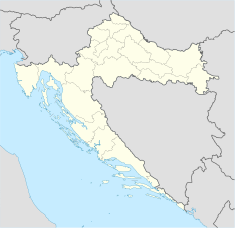Zagreb Cathedral
| Zagreb Cathedral | |
|---|---|
| Cathedral of the Assumption of Mary | |
Croatian: Zagrebačka katedrala
| |
 Zagreb Cathedral after the 2020 earthquake
| |
 Zagreb Cathedral | |
| 45°48′52″N 15°58′47″E | |
| Location | Zagreb |
| Country | Croatia |
| Denomination | Roman Catholic |
| History | |
| Status | Cathedral |
| Relics held | Sarcophagus of Blessed Aloysius Stepinac, Croatian martyrs Petar Zrinski and Fran Krsto Frankopan, whose bones were transferred from Wiener Neu Stadt in 1919 A.D., Ivan Antun Zrinski, Eugen Kvaternik etc |
| Architecture | |
| Functional status | Active |
| Heritage designation | Register of Cultural Goods of Croatia |
| Designated | 2013 |
| Architect(s) | Hermann Bollé (last reconstruction) |
| Style |
Gothic (original) Gothic Revival (19th century reconstructions) |
| Years built | Mid-13th century 1880–1906 (reconstruction/additions) |
| Specifications | |
| Number of spires | 2 |
| Spire height | 108 m (354 ft) |
| Bells | 5 (North Tower) 3 (South Tower) |
| Administration | |
| Archdiocese | Zagreb |
| Clergy | |
| Archbishop | Dražen Kutleša |
|
Native name Croatian: Zagrebačka katedrala | |
 Location of Zagreb Cathedral in Croatia
| |
| Location | Zagreb, Croatia |
| Architect | Hermann Bollé (last reconstruction) |
| Governing body | Zagrebačka katedrala |
| Type | Movable cultural good |
| Designated | March 9, 2013 |
| Reference no. | P-3621 |
| Protected assets | Plenarium and crucifix from the cathedral treasury |
Zagreb Cathedral, located at Kaptol, Zagreb, is a Roman Catholic cathedral-church. It is the second tallest building in Croatia and also the most monumental sacral building in Gothic style southeast of the Alps. It is dedicated to the Assumption of Mary and to kings Saint Stephen and Saint Ladislaus. The cathedral is typically Gothic, as is its sacristy, which is of great architectural value. Its prominent spires are considered to be landmarks as they are visible from most parts of the city. One of its two spires was damaged in the 2020 Zagreb earthquake.
History
In 1093 when King Ladislaus I of Hungary (1040-1095) moved the bishop's chair from Sisak to Zagreb, he proclaimed the existing church as a cathedral. Construction on the cathedral started shortly after his death and was finished in 1217 and consecrated by king Andrew II of Hungary. The building was destroyed by the Mongols in 1242 but rebuilt by bishop Timothy (1263–1287) a few years later. At the end of the 15th century, the Ottoman Empire invaded Croatia, triggering the construction of fortification walls around the cathedral, some of which are still intact. In the 17th century, a single fortified renaissance watchtower was erected on the south side and was used as a military observation point, because of the Ottoman threat.
The cathedral was severely damaged in the 1880 Zagreb earthquake. The main nave collapsed and the individual tower was damaged beyond repair. The restoration-reconstruction of the cathedral in Neo-Gothic style was led by Hermann Bollé, bringing the cathedral to its present form. As part of that restoration, two spires 104 m (341 ft) high were raised on the western side, both of which are now in the process of being restored as part of an extensive general restoration of the cathedral.
The cathedral was depicted on the reverse of the Croatian 1000 kuna banknote issued in 1993.
Renovations on the cathedral's towers began in 1990, and have not been completely free of scaffolding for over three decades.
When facing the portal, the building is 46 meters wide and 104 and 105 meters high, respectively. The cathedral contains a relief of Cardinal Aloysius Stepinac with Christ done by the Croatian sculptor Ivan Meštrović. The cathedral was visited by Pope Benedict XVI on 5 June 2011 where he celebrated Sunday Vespers and prayed before the tomb of Blessed Aloysius Stepinac.
The cathedral was damaged in the 2020 earthquake on 22 March, in which the tip of its southern spire broke off and crashed onto the roof of the adjacent Archbishop's Palace. On 17 April 2020, the northern spire of Zagreb Cathedral was removed due to leaning during the earthquake.
Treasury
The cathedral holds a treasury (riznica) that include various metal vessels, liturgical vestments, and liturgical books collected during various periods of its history. Among these objects most notable are:
- medieval St. Ladislaus cloak
- Plenarium made out of ivory
- baroque Reliquary-bust of King Saint Stephen
- a Betlehem child mummy apparently killed by the order of king Herod and brought to Zagreb by king Andrew II
- an apparent piece of a true cross
- a piece of king Ladislaus' arm
Gallery
-
 1880 pre-earthquake Cathedral and its tower's view from Jelačić Square with old square spire
1880 pre-earthquake Cathedral and its tower's view from Jelačić Square with old square spire -
 Post 1880 view with fortifications intact
Post 1880 view with fortifications intact -
Facade
-
Mary column in front of the Cathedral
-
Entrance portal
-
 Eastern view
Eastern view -

-
 Nave, altar and pulpit
Nave, altar and pulpit -
 Gargoyle on Zagreb Cathedral
Gargoyle on Zagreb Cathedral -
 Cathedral in view behind St. Mark's Church in the foreground
Cathedral in view behind St. Mark's Church in the foreground -
 Neo-Gothic tower on Zagreb Cathedral
Neo-Gothic tower on Zagreb Cathedral -
Lateral interior
-
Stained glass
-
Interior nave
-
Coffin
-
Altar
-
 Holy mass
Holy mass
















